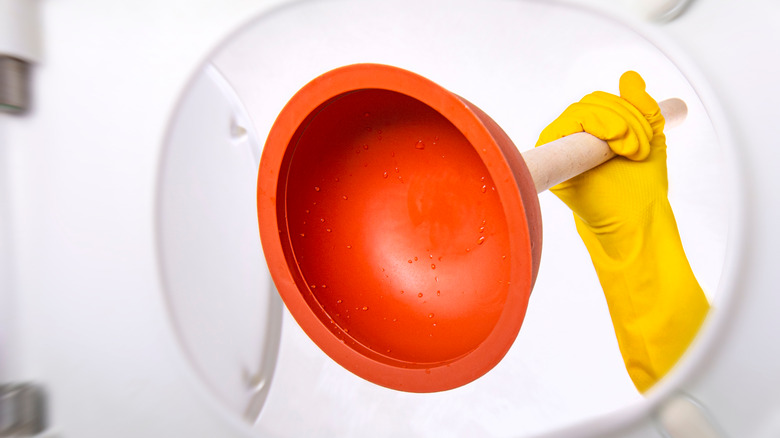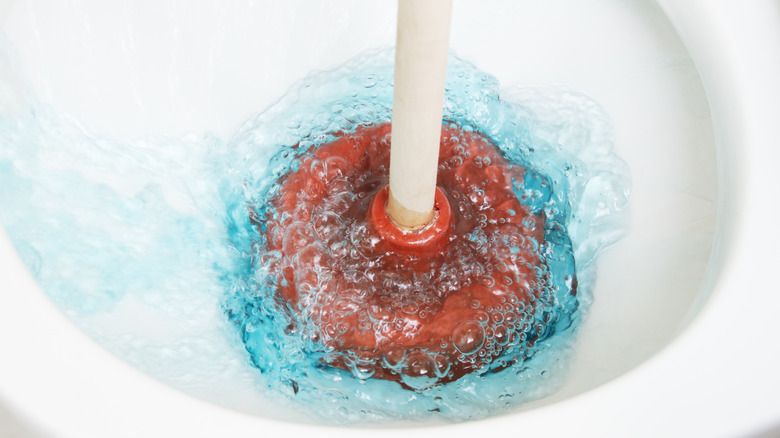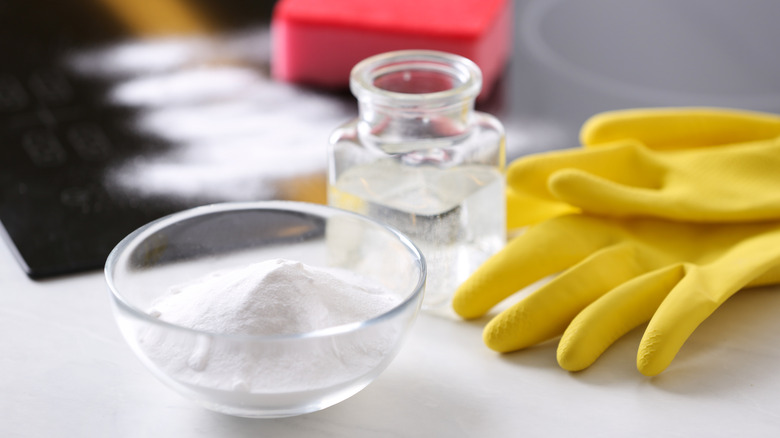The Best Way To Really Unclog Your Toilet
We may receive a commission on purchases made from links.
As embarrassing as it may be, everyone runs into the issue of a clogged toilet at least once in their life. A toilet can clog for a variety of reasons, according to All City Plumbing, ranging from a clogged drain line to not enough water in the tank, but regardless of the reason, dealing with the issue can be stressful and embarrassing. Although some clogs are due to underlying issues with your toilet, which should be brought to a professional's attention, most clogs can be easily resolved with items and tools you have in your own home.
Unclogging a toilet is a seemingly simple task, but when stubborn clogs occur or you don't have the tools you need, a little extra help might be required. Regardless of the situation, House Digest is here to help with the best tips and tricks to help you resolve your next clogged toilet with ease.
Plunger options
When it comes to plungers, there are a variety of types you can choose from. Before choosing, however, you must understand that a plunger that is too big or too small for your toilet will not effectively clear clogs and could potentially cause damage to your toilet. Bob Vila recommended three of the best plungers that can resolve even the toughest of clogs.
The Korky Telescoping BeeiveMAX Universal plunger is a very powerful plunger designed to fit various toilets. It is made of durable rubber and has an adjustable handle, maximizing comfort during the task. A NEIKO toilet plunger has a unique design that can fit any toilet bowl. Not only does it have strong functionality, but it is also very easy to clean. Finally, the Supply Guru Heavy Duty plunger is a cheaper option that still advertises great functionality. Its shape provides a high suction force, perfect for easily clearing blocked drains.
Gear to wear
Unclogging a toilet can be a messy task; therefore, it's important for you to have the right gear to keep your body safe during the process. To keep your hands free, rubber gloves are highly recommended for the task. Insider suggested the Casabella Waterblock Gloves, which have high ratings for their comfort, protection, and firm grip — which will help from making any additional messes. Although they are made with a latex material, they are lined with cotton to increase their comfort while wearing them and make them very easy to slip on and off before and after being used.
In addition to wearing gloves, safety glasses are also useful when wanting to protect your eyes from stray splashes that could form while plunging. The Spruce highly recommended the NoCry Safety Glasses because they are not only adjustable to head sizes but are also designed to fit prescription glasses underneath.
Plunging properly
More often than not, a plunger alone is more than enough to unclog a toilet. Although this tool is very easy to use, Family Handyman suggested some tips you can follow to make plunging easier, cleaner, and more effective. First and foremost, make sure your plunger fits your toilet. A proper plunger should completely seal the toilet drain.
When making your first plunge, ensure it is a gentle one. Because the bell of your plunger will be full of air on that first plunge, it could easily blow toilet water all over your bathroom if you plunge too hard. After that first plunge, however, you can begin plunging more quickly and forcefully while maintaining the seal over the drain. Also, make sure that there is enough water in your toilet bowl as you plunge. There should always be enough water to cover the plunger because forcing air through the drain is not as effective as forcing water through. Doing this technique fifteen to twenty times should effectively loosen the clog. If it doesn't loosen right away, be patient and keep at it.
Try a toilet brush
Although this method may sound a bit messy and gross, it can be helpful when trying to unclog a toilet without the access to a plunger. Although it may not be as effective as a plunger, it can be enough to loosen up a clog. The tough bristles on a toilet brush can be strong enough to produce a slight suction.
Bob Vila said to just angle the brush into the toilet drain and pump up and down as you would with the plunger motion. It shouldn't take too long for the clog to loosen if it's not a bad one. Keep in mind that using a toilet brush is not as effective as using a plunger, but it can work for smaller clogs; it will give you some time to go get a plunger from the store. This method, however, can be mixed with another non-plunging method to work more effectively on bigger clogs.
Baking soda and vinegar
Sometimes the clog in your toilet may be too stubborn for a plunger, and you need a little extra help. Instead of turning to harsh chemicals that could potentially hurt your pipes, you can use two non-toxic ingredients you probably have in your home right now: baking soda and vinegar. There are a number of cleaning hacks that use baking soda and vinegar to deodorize and clean all types of surfaces, and drains are no different. These two simple ingredients are great for keeping drains clean and running smoothly, according to Plumbing Troopers.
Start by adding a cup of baking soda to your toilet bowl, then wait a few minutes before slowly adding in two cups of vinegar. Allow the solution to sit for a few minutes before flushing the toilet. The toilet should make a suction sound then drain normally when the solution has worked. This process may need to be repeated a couple of times if it does not flush the first time.
Hot water and dish soap
Hot water and dish soap is another method to try when your stubborn clog won't release. Dish soap alone can unclog a toilet by making the contents of the clog easily slip through the pipes, but it doesn't always work alone. Hot water can be added in with the soap to help unclog the toilet.
According to Home Guides, squirt about a half cup of dish soap into the toilet and let it sit for about ten minutes. While the soap sits, heat a pot of water on the stove. Preferably, use a pot with handles, which allows you to easily transport the hot water to the bathroom. Heat until tiny bubbles start to form in the water. This should happen right before the water begins to boil. Quickly and carefully pour the hot water into the toilet bowl with the soap. If the water doesn't automatically disappear down the drain, then you should use a plunger to plunge a few more times before trying to flush.
Plumbing snake
A plumbing snake is one of the best tools to use against a stubborn clog, according to Benjamin Franklin. Although there are many different types of plumbing snake designs, they all work in a similar way. Just feed the flexible end of the snake into the toilet drain and keep feeding until you reach the clog. Then, twist the tool to break up and dislodge the clog. Never use a plumbing snake that is too big for your toilet, and always pull the snake out of the toilet in a slow, controlled manner to avoid a bathroom mess.
This same method can be done with a wire coat hanger if you don't have access to a plumbing snake. To do so, take a wire coat hanger and cut it with pliers near the hook of the hanger. Then straighten out the hanger into a cane-like shape. Feed the hooked side into the toilet drain to break up and dislodge the waste like a plumbing snake (per Popular Mechanics).
Preventing clogs
Although it is not often that you purposefully cause your toilet to clog, there are some easy prevention techniques that can keep your drains running smoothly. The easiest thing you can do is keep your toilet cover down when the toilet is not in use, especially if you have small children. Toys, crayons, and other small objects can easily be thrown or dropped into the toilet and cause a clog. Depending on the location of your toilet, things can easily just fall in by accident, as well. An easy prevention for this is creating a barrier by closing the toilet lid when it is not in use, suggested Family Handyman.
Carefully selecting what liquids are dumped down your toilet can also help prevent clogs. Sometimes hardening compounds get dumped down your toilet without you even realizing its potential for clogging your drains. For example, grease and wax products may be liquid when you pour them into the toilet, but these compounds can quickly harden and cause a clog in your drain. To ensure this doesn't happen, check to make sure that the compounds you pour down your drains are liquids that always remain liquids.








